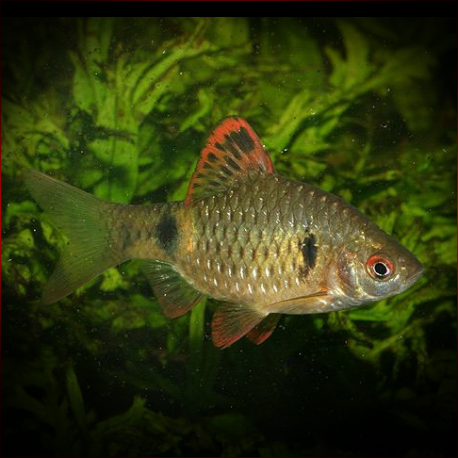More info
Datasheet
| Minimum Tank Size | 60 litres / 15.85 US gallons |
| Maximum Size | 4.1cm / 1.61inches |
| Temperature | 20°C / 68.00°F - 27°C / 80.60°F |
| Hardness | 1.01dgH / 18ppm - 12.05dgH / 215ppm |
| pH | 5.5-7.0 |
General Description
Pethia cumingii, commonly known as Cuming's Barb, is a peaceful and colorful fish that was once considered to have two color forms but now distinguished from the species P. reval. Adult males are slimmer and more vibrant, especially during spawning. They are small in size, with the maximum recorded length being 4.1cm. This species exhibits unique fin coloration and black blotches along the body, making it distinct from other related species.
Aquarium Setup
For housing Pethia cumingii, a minimum tank size of 60 liters is recommended. They do well in a community aquarium with other peaceful fish species. It is advised to keep them in schools of 6-10 individuals to reduce skittish behavior and promote better coloration among males. The barbs prefer a heavily planted tank with dark substrate, floating plants, and driftwood to provide cover and a natural environment. Maintaining water conditions within a pH range of 5.5-7.0, hardness between 18-215ppm, and a temperature of 20-27°C is ideal for their well-being.
Behaviour
Pethia cumingii is a schooling fish by nature, emphasizing the need for a group of individuals in the aquarium. They are peaceful and can coexist with various fish species, making them a suitable addition to community tanks. The presence of conspecific rivals can enhance the colors of male barbs. In terms of behavior, they are generally non-aggressive and do not have specific water chemistry requirements, allowing for compatibility with popular aquarium fish like tetras, catfish, and loaches.
Feeding and Diet
In their natural habitat, Pethia cumingii forages on diatoms, algae, insects, worms, and zooplankton. In the aquarium, they readily accept a diet of small live and frozen foods such as bloodworms, Daphnia, and Artemia. Supplementing their diet with quality dried flakes and granules containing plant or algal content is also recommended. Regular feeding will help maintain their condition and vibrant colors.
Reproduction & Dimorphism
These barbs are egg-scattering free spawners and exhibit no parental care. To encourage breeding, a separate breeding tank with dim lighting and appropriate spawning substrate is suggested. Male barbs are more colorful and slender than females, especially evident during spawning. Providing optimal water conditions and a controlled breeding setup can yield successful spawns, with fry needing specialized food until they are large enough to consume microworms or Artemia nauplii.
Habitat and Distribution
Pethia cumingii is endemic to the Bentara and Gin river drainages in southwestern Sri Lanka. Their natural habitat consists of flowing streams with substrates of sand, gravel, or rocks. However, the species faces threats due to habitat degradation and selective collection for the aquarium trade. Conservation efforts are crucial as the loss of native forest cover has impacted water quality, endangering the survival of this species in the wild.

